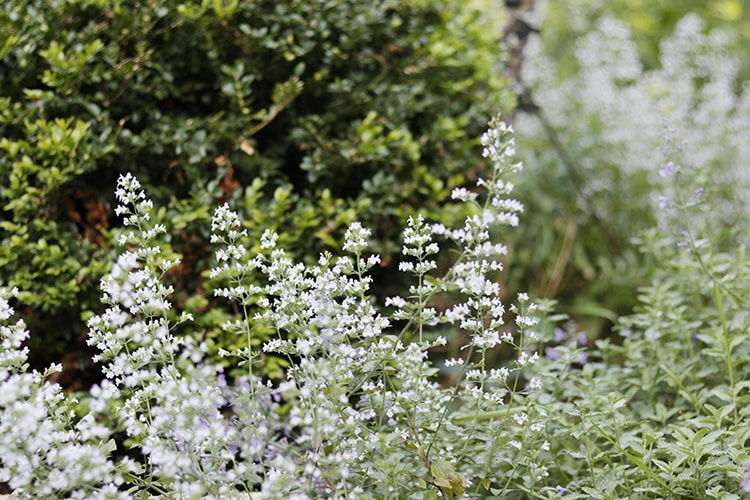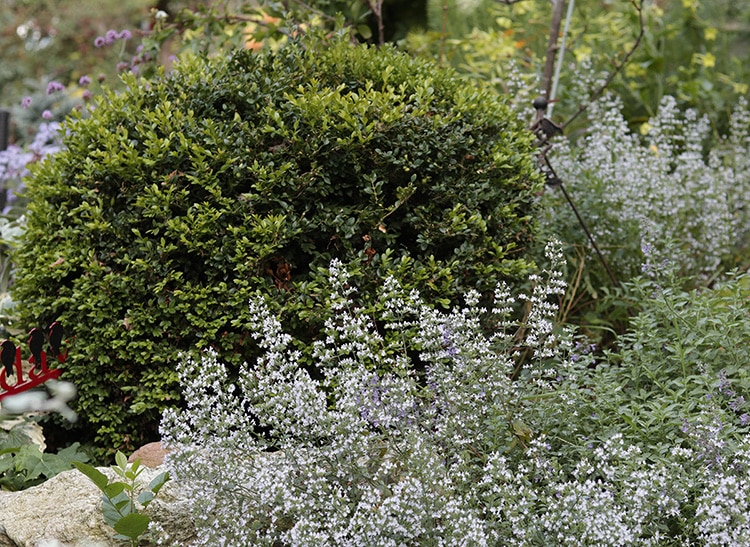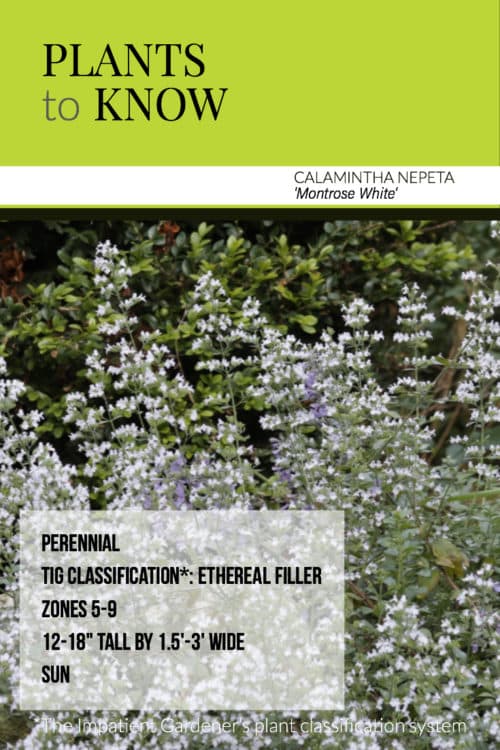I was skeptical when I first heard about Calamintha nepeta ‘Montrose White’. I’d been to multiple garden talks in which speakers extolled the virtues of this plant. It was a “must-have” they said. But I didn’t think it looked particularly spectacular in photos.
Still, I’m a sucker for a new-to-me plant if multiple people have told me how great it is, it wasn’t long before I ended up putting some in my garden. And guess what? It’s now on my must-have list too.

It is difficult to describe this plant because it’s not bold, and it generally looks terrible in a nursery pot. But put it in the ground, walk away and come back one day to a fluffy, ethereal, frothy mass that seems to have come from nowhere. It manages to be both airy and grounding at the same time.
The flowers, which come in later summer and last for several weeks, are tiny little florets that extend nearly the length of the stem. I would say they remind me a little of baby’s breath except that I hate baby’s breath. They have the blueish-gray foliage typical of the nepeta family and the overall effect of the plant when in flower is a white haze. But closer inspection shows the flowers to have a tinge of pink of them.
Calamintha is a member of the mint family, but there’s no need to worry about the manner of ‘Montrose White.’ Unlike many others, this is sterile, so it won’t reseed. It wants sun but handles afternoon shade fine even in my northern garden. I would guess it may appreciate a bit more protection on the hottest days in the top end of its zone 5 to 9 range and winter hardiness has not been an issue in my zone 5 garden. It is said to prefer well-drained soil but I’ve seen it growing in several heavy-clay gardens with seemingly no issues.

There’s nothing to be done with this plant in the way of maintenance beyond cutting it back in fall or spring after it dies back. And, many gardeners will especially appreciate that it is unsavory to the critters that torture gardens and roam on four long or short legs. Even more gardeners will appreciate that is very savory to bees and other pollinators. There were times last summer when I’d walk by and ‘Montrose White’ seemed to be literally buzzing there were so many bees on it. It’s not difficult to see why it was the Perennial of the Year in 2010.
I’m a fan of a juxtaposition of textures in the garden and Calamintha nepeta works wonderfully in the fine texture roll. It looks best planted with plants of a bolder texture. Last year I planted it with Heucherella Primo Black Pearl and Hydrangea serrata Tuff Stuff, but I’ve grown it next to a large boxwood for several years and I love the look in both places.
There aren’t a lot of plants that can do it all—please the bees and the gardener and discourage deer—and manage to have grace and presence without a lot of fuss, but ‘Montrose White’ manages to fulfill that promise.



19 Responses
I am anxious to try this plant! I have so many deer and am trying to find things that bloom in the summer the deer don’t care much for them. I have looked online… but I can’t seem to find anyone who sells it… Do have a list of companies that sell it?
I know this is an older post but I’m wondering if you still see this one being sold, I haven’t seen it. But it’s gorgeous!
PS I just love watching your videos and have just begun on your blog. Thank you for all the info!
I bought it in May at a local garden center here in northern Illinois, The Growing Place, and I just saw it there again on Thursday
I like how you describe it
” both airy and grounding at the same time.”
Beautiful
I ordered and planted this in the spring, following this post. It has done as promised! There is one particularly species of native bee that LOVES it. I placed it surrounding a strawberry tree, which gives a same-but-different effect. The stems of both are upswept, but the dark large leaves of the strawberry tree make the tiny white flowers pop. I cannot wait to see what another year or two of getting established will do. Thanks for the recommendation!
YAY! I’m so glad you’re liking it. It really is a bee magnet. Thanks for letting me know it’s working for you!
Erin, love your YT channel. Thank you fof all the effort you put into your gardens and sharing everything with us.
Question about.calamintha nepeta montrose white…I’m told this is a sterile plant. If so, are the bees actually getting any nutrition from it?
Thank you
Ann (aka FarmBarbie)
Any good online sources for purchasing this specific variety? I have found the Calamintha nepeta and the “White Cloud” cultivar but not having much luck with “Montrose White.”
Any thoughts on Calamintha ‘Montrose White’ vs ‘White Cloud’?
Trying to get the best cultivar for my non-gardening sis-in-law to replace the ratty hosta which aren’t handling the MI rock garden well.
Sandy soil, filtered am sun, full on mid day sun, shaded from the West.
I’ve not grown ‘White Cloud’ so I can’t speak from experience, but I have read about it a little. I think you’d be safe with either, to be honest. I better your sister-in-law will love it!
Ooh, I want this one! I like the purple calamintha as well, but I’m sure I could find a place for this beauty!
By the way, I need to just bookmark your dahlia posts, I’ve been going back to them so often! This is my first year growing dahlias. Like you, I am in zone 5, though microclimate probably closer to 4, so I’ve got awhile yet before they can be planted out into the garden. Thanks to your excellent instructions I’ve gotten them potted up (16 more came today!) and am eagerly awaiting the first green shoots to appear. Thank you for all the hard work and time you put into this blog!
Seeing the pictures of this has me so excited for it to emerge in the garden. I grow Calamintha nepeta ssp. nepeta which is a tad more lavender in color but otherwise the same wonderful plant.
I will be sure to look for this plant at the plant sales U will be attending this spring. Like the idea of it being bed friendly as well as a fuller around not so pretty stems like alloys and some poppies. Love the soft texture it adds to the garden.
I put this in my garden last summer and just so love (and so do the bees). I highly recommend.
This spring/summer I will be putting in a patio/garden in place of where I had an above ground pool and deck. My plan is for whites, blues, purples, greens, and silvers and I am looking forward to including some of this.
Love, love, love this plant. Makes a statement but isn’t overwhelming. Reliable. Hides bare legs and strong stemmed plants will grow right through it. Practically vibrates with pollinators. Wouldn’t be without it.
Great points! It is great for hiding bare legs!
Sounds like a good one to have in the garden. I have one of the purple ones and it does well. I might give this one a try.
Definitely give it a shot!